Human Resource Management Analysis of Staff Practices Report
VerifiedAdded on 2023/06/04
|14
|1942
|318
Report
AI Summary
This report presents a Human Resource Management (HRM) analysis of staff practices across four business locations: Brighton, Eaton, Denver, and Victoria. The analysis utilizes data and metrics related to staff characteristics, efficiency, effectiveness, and business outcomes. The report examines demographic profiles, including education, work experience, and gender distribution across different divisions. Efficiency is measured through average salaries, while effectiveness is assessed using parameters like performance and sponsor satisfaction. Business outcomes are evaluated through productivity, profitability, and the Bradford factor. The findings highlight variations in staff characteristics, salary levels, and performance metrics across locations and business divisions (Home Cares and Community Outings). Key observations include the relationship between education and job roles, gender distribution within the workforce, and the impact of work experience. The analysis also explores average salary differences, performance rankings, and the correlation between high potential and sponsor satisfaction. Furthermore, the report investigates productivity and profitability trends, along with an assessment of the Bradford factor as a measure of employee absenteeism. The report concludes with key highlights, discussion points, and recommendations for improving organizational performance through enhanced training, cost reduction, and strategic leadership.
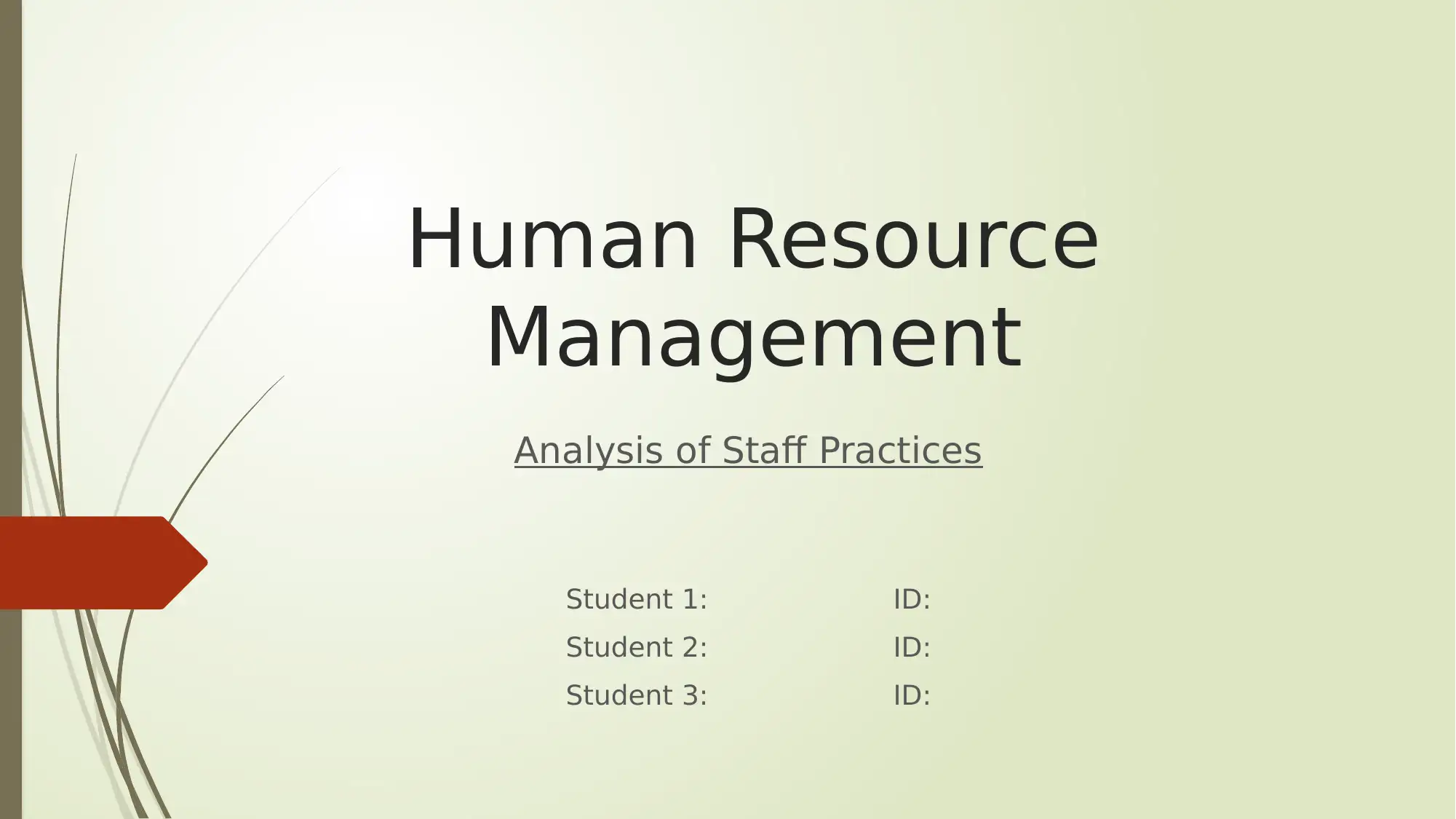
Human Resource
Management
Analysis of Staff Practices
Student 1: ID:
Student 2: ID:
Student 3: ID:
Management
Analysis of Staff Practices
Student 1: ID:
Student 2: ID:
Student 3: ID:
Secure Best Marks with AI Grader
Need help grading? Try our AI Grader for instant feedback on your assignments.
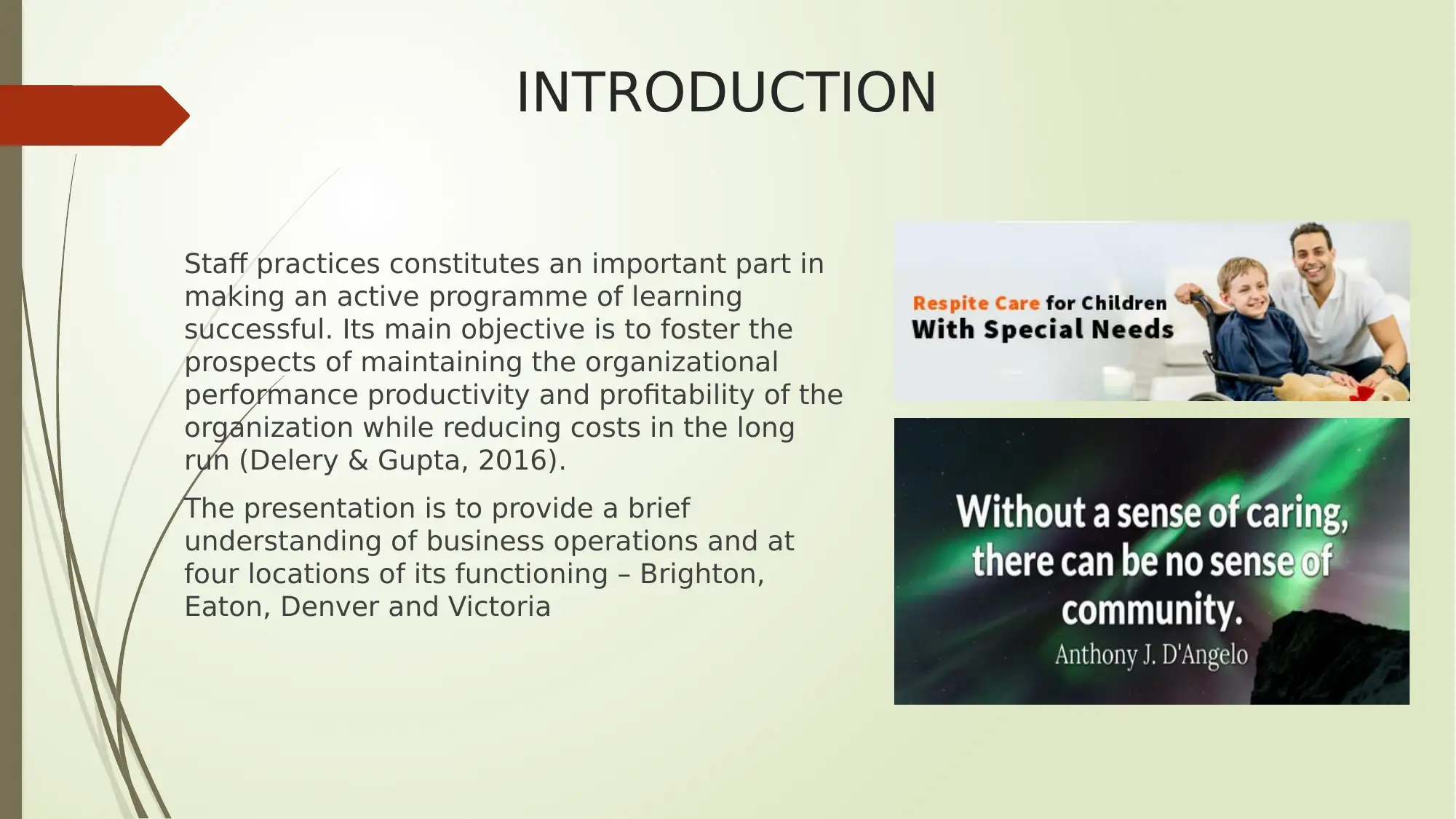
INTRODUCTION
Staff practices constitutes an important part in
making an active programme of learning
successful. Its main objective is to foster the
prospects of maintaining the organizational
performance productivity and profitability of the
organization while reducing costs in the long
run (Delery & Gupta, 2016).
The presentation is to provide a brief
understanding of business operations and at
four locations of its functioning – Brighton,
Eaton, Denver and Victoria
Staff practices constitutes an important part in
making an active programme of learning
successful. Its main objective is to foster the
prospects of maintaining the organizational
performance productivity and profitability of the
organization while reducing costs in the long
run (Delery & Gupta, 2016).
The presentation is to provide a brief
understanding of business operations and at
four locations of its functioning – Brighton,
Eaton, Denver and Victoria

DATA AND METRICS DESCRIPTION
Sample Data File provided holds the basic staff characteristics with efficiency,
effective and most importantly the profitability characteristics.
The Metrics examined for the analysis are given as:
1. Basic Staff Characteristics
The demographic profile of the staff with education, work experience, gender and
division of business operations handled by the staff.
2. Efficiency measures
The average salary of the staff in each division and in different location can point
out the role to profitability and the areas where further analysis is needed.
Sample Data File provided holds the basic staff characteristics with efficiency,
effective and most importantly the profitability characteristics.
The Metrics examined for the analysis are given as:
1. Basic Staff Characteristics
The demographic profile of the staff with education, work experience, gender and
division of business operations handled by the staff.
2. Efficiency measures
The average salary of the staff in each division and in different location can point
out the role to profitability and the areas where further analysis is needed.
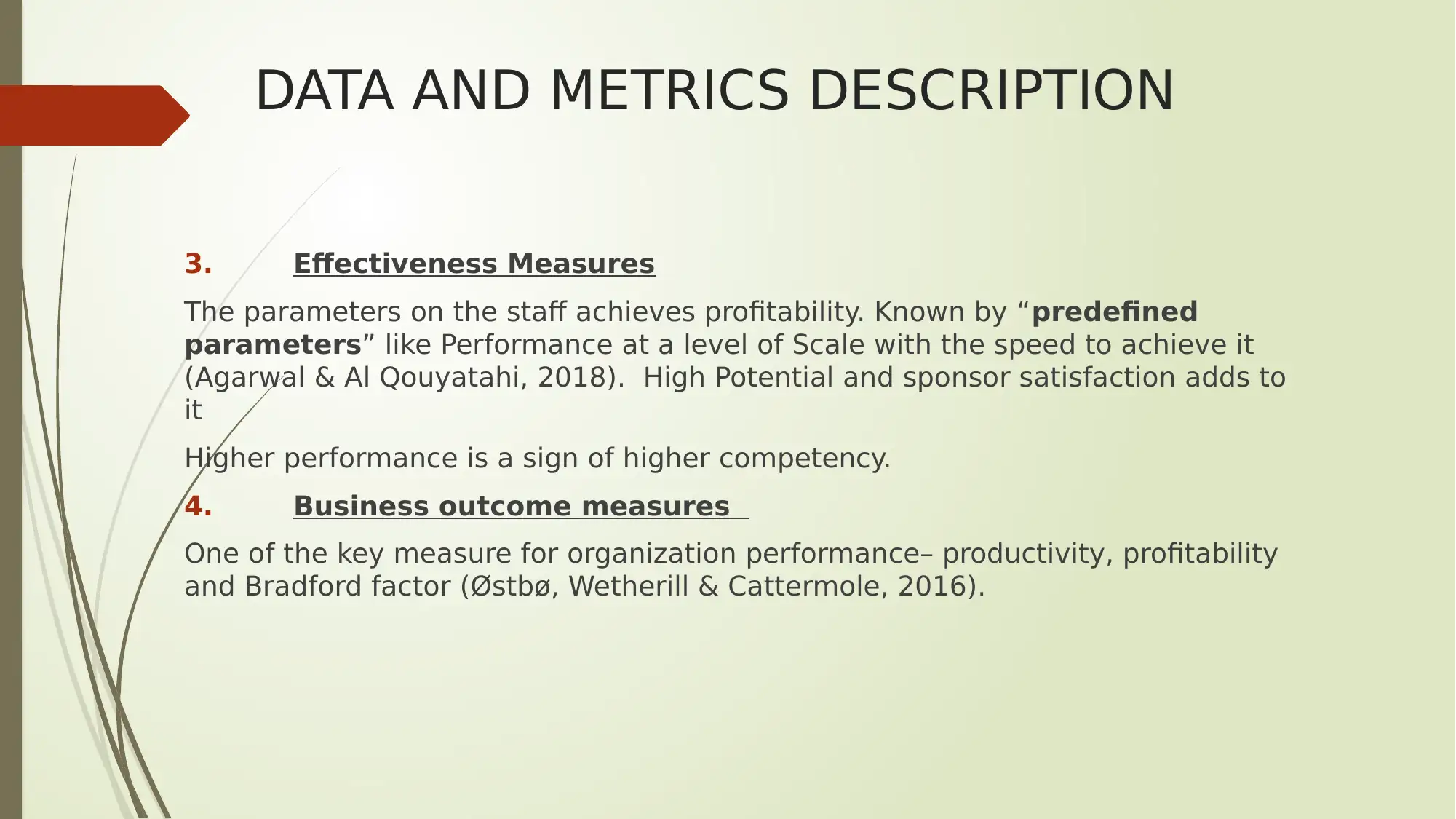
DATA AND METRICS DESCRIPTION
3. Effectiveness Measures
The parameters on the staff achieves profitability. Known by “predefined
parameters” like Performance at a level of Scale with the speed to achieve it
(Agarwal & Al Qouyatahi, 2018). High Potential and sponsor satisfaction adds to
it
Higher performance is a sign of higher competency.
4. Business outcome measures
One of the key measure for organization performance– productivity, profitability
and Bradford factor (Østbø, Wetherill & Cattermole, 2016).
3. Effectiveness Measures
The parameters on the staff achieves profitability. Known by “predefined
parameters” like Performance at a level of Scale with the speed to achieve it
(Agarwal & Al Qouyatahi, 2018). High Potential and sponsor satisfaction adds to
it
Higher performance is a sign of higher competency.
4. Business outcome measures
One of the key measure for organization performance– productivity, profitability
and Bradford factor (Østbø, Wetherill & Cattermole, 2016).
Secure Best Marks with AI Grader
Need help grading? Try our AI Grader for instant feedback on your assignments.
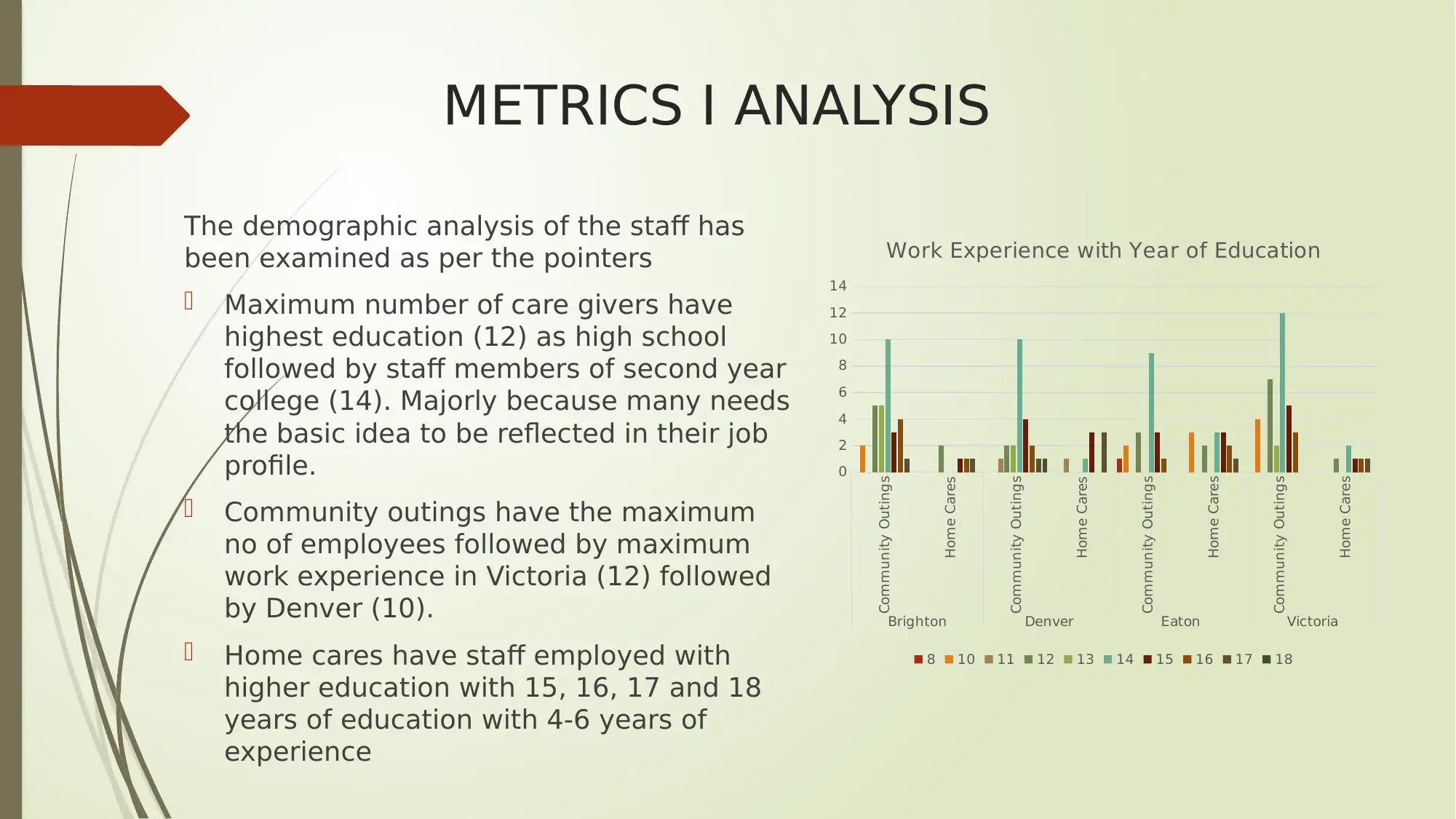
METRICS I ANALYSIS
The demographic analysis of the staff has
been examined as per the pointers
Maximum number of care givers have
highest education (12) as high school
followed by staff members of second year
college (14). Majorly because many needs
the basic idea to be reflected in their job
profile.
Community outings have the maximum
no of employees followed by maximum
work experience in Victoria (12) followed
by Denver (10).
Home cares have staff employed with
higher education with 15, 16, 17 and 18
years of education with 4-6 years of
experience
Community Outings
Home Cares
Community Outings
Home Cares
Community Outings
Home Cares
Community Outings
Home Cares
Brighton Denver Eaton Victoria
0
2
4
6
8
10
12
14
Work Experience with Year of Education
8 10 11 12 13 14 15 16 17 18
The demographic analysis of the staff has
been examined as per the pointers
Maximum number of care givers have
highest education (12) as high school
followed by staff members of second year
college (14). Majorly because many needs
the basic idea to be reflected in their job
profile.
Community outings have the maximum
no of employees followed by maximum
work experience in Victoria (12) followed
by Denver (10).
Home cares have staff employed with
higher education with 15, 16, 17 and 18
years of education with 4-6 years of
experience
Community Outings
Home Cares
Community Outings
Home Cares
Community Outings
Home Cares
Community Outings
Home Cares
Brighton Denver Eaton Victoria
0
2
4
6
8
10
12
14
Work Experience with Year of Education
8 10 11 12 13 14 15 16 17 18
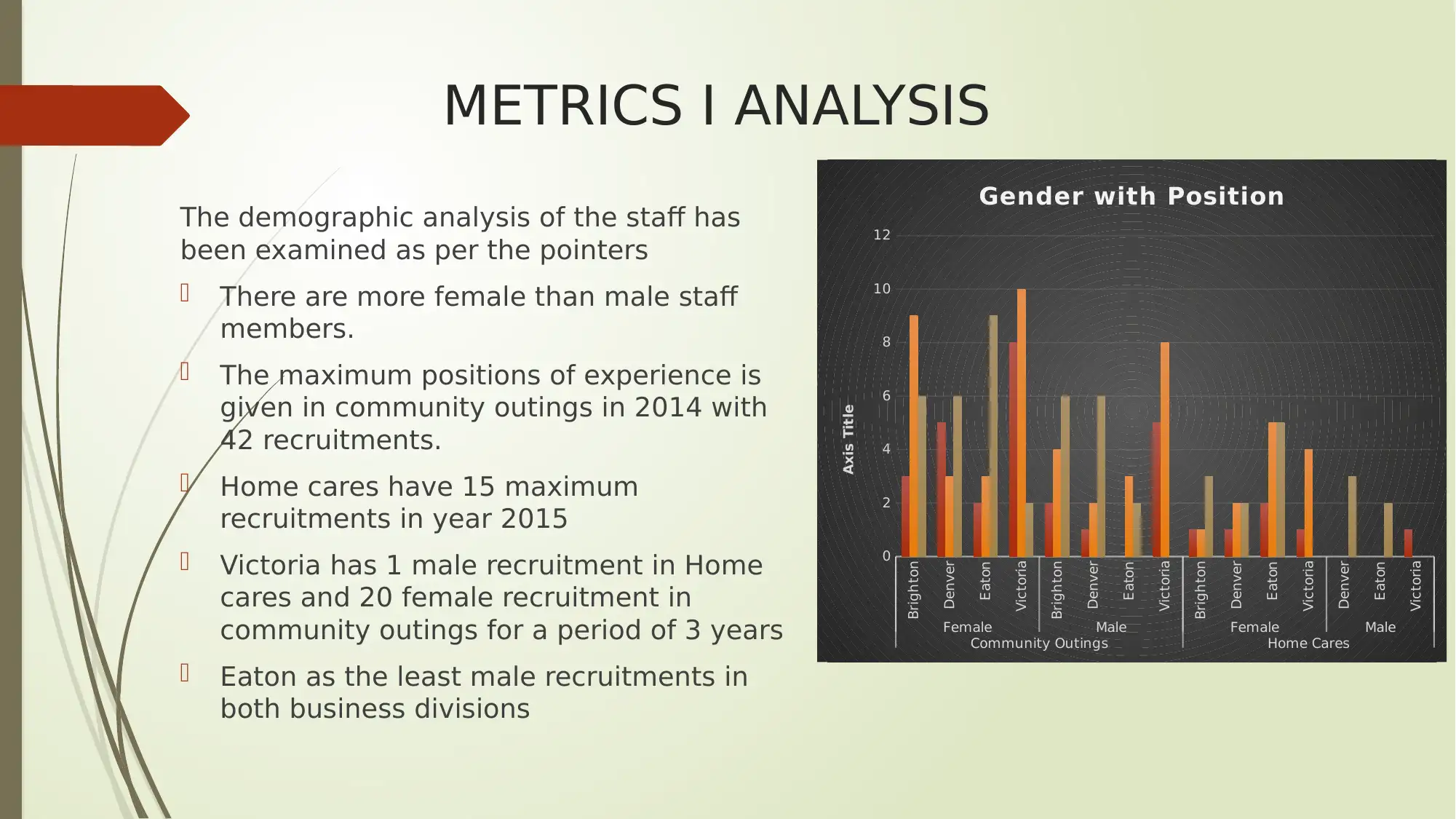
METRICS I ANALYSIS
The demographic analysis of the staff has
been examined as per the pointers
There are more female than male staff
members.
The maximum positions of experience is
given in community outings in 2014 with
42 recruitments.
Home cares have 15 maximum
recruitments in year 2015
Victoria has 1 male recruitment in Home
cares and 20 female recruitment in
community outings for a period of 3 years
Eaton as the least male recruitments in
both business divisions
Brighton
Denver
Eaton
Victoria
Brighton
Denver
Eaton
Victoria
Brighton
Denver
Eaton
Victoria
Denver
Eaton
Victoria
Female Male Female Male
Community Outings Home Cares
0
2
4
6
8
10
12
Gender with Position
Axis Title
The demographic analysis of the staff has
been examined as per the pointers
There are more female than male staff
members.
The maximum positions of experience is
given in community outings in 2014 with
42 recruitments.
Home cares have 15 maximum
recruitments in year 2015
Victoria has 1 male recruitment in Home
cares and 20 female recruitment in
community outings for a period of 3 years
Eaton as the least male recruitments in
both business divisions
Brighton
Denver
Eaton
Victoria
Brighton
Denver
Eaton
Victoria
Brighton
Denver
Eaton
Victoria
Denver
Eaton
Victoria
Female Male Female Male
Community Outings Home Cares
0
2
4
6
8
10
12
Gender with Position
Axis Title
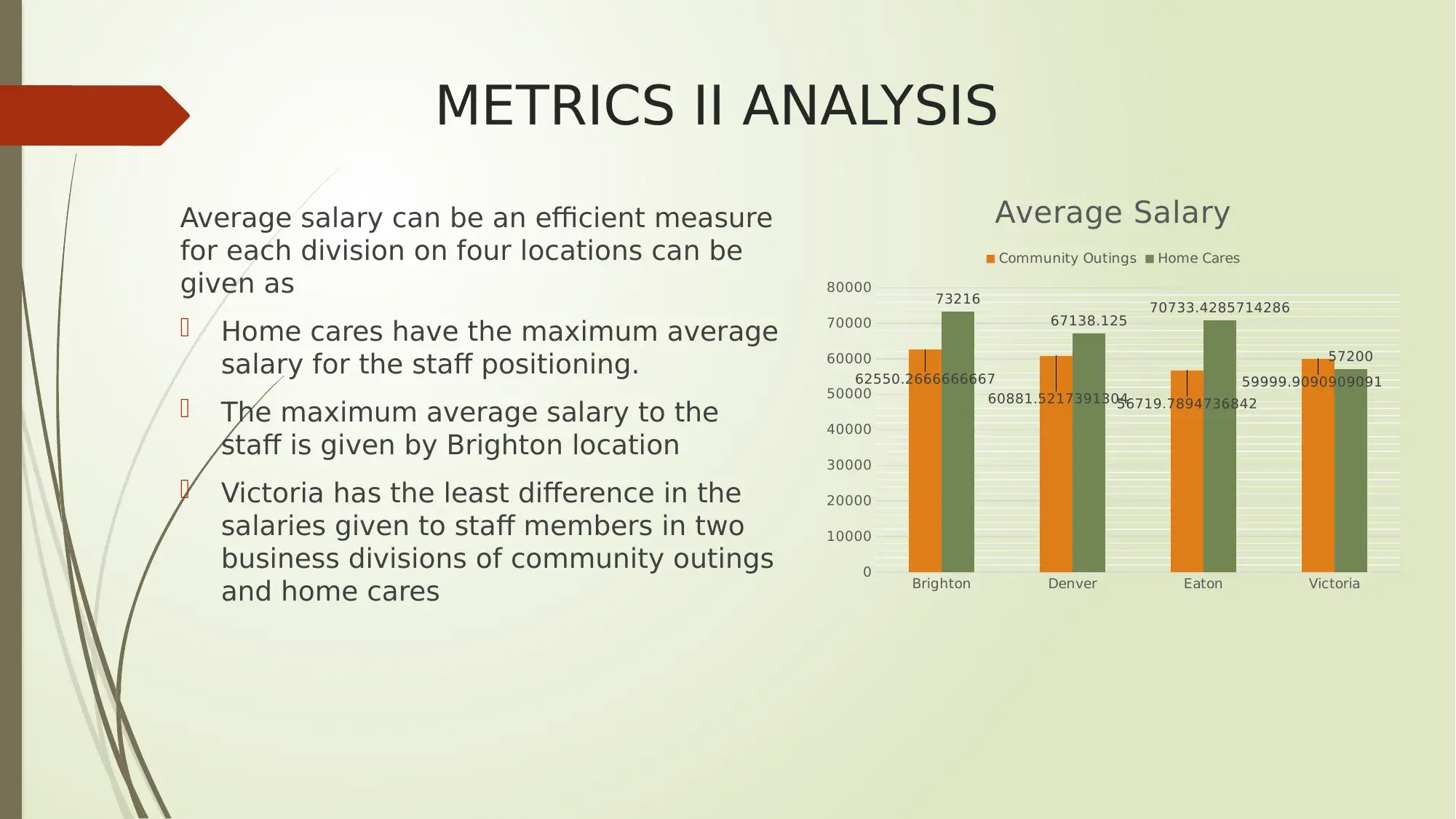
METRICS II ANALYSIS
Average salary can be an efficient measure
for each division on four locations can be
given as
Home cares have the maximum average
salary for the staff positioning.
The maximum average salary to the
staff is given by Brighton location
Victoria has the least difference in the
salaries given to staff members in two
business divisions of community outings
and home cares Brighton Denver Eaton Victoria
0
10000
20000
30000
40000
50000
60000
70000
80000
62550.2666666667
60881.521739130456719.7894736842
59999.9090909091
73216
67138.125 70733.4285714286
57200
Average Salary
Community Outings Home Cares
Average salary can be an efficient measure
for each division on four locations can be
given as
Home cares have the maximum average
salary for the staff positioning.
The maximum average salary to the
staff is given by Brighton location
Victoria has the least difference in the
salaries given to staff members in two
business divisions of community outings
and home cares Brighton Denver Eaton Victoria
0
10000
20000
30000
40000
50000
60000
70000
80000
62550.2666666667
60881.521739130456719.7894736842
59999.9090909091
73216
67138.125 70733.4285714286
57200
Average Salary
Community Outings Home Cares
Paraphrase This Document
Need a fresh take? Get an instant paraphrase of this document with our AI Paraphraser
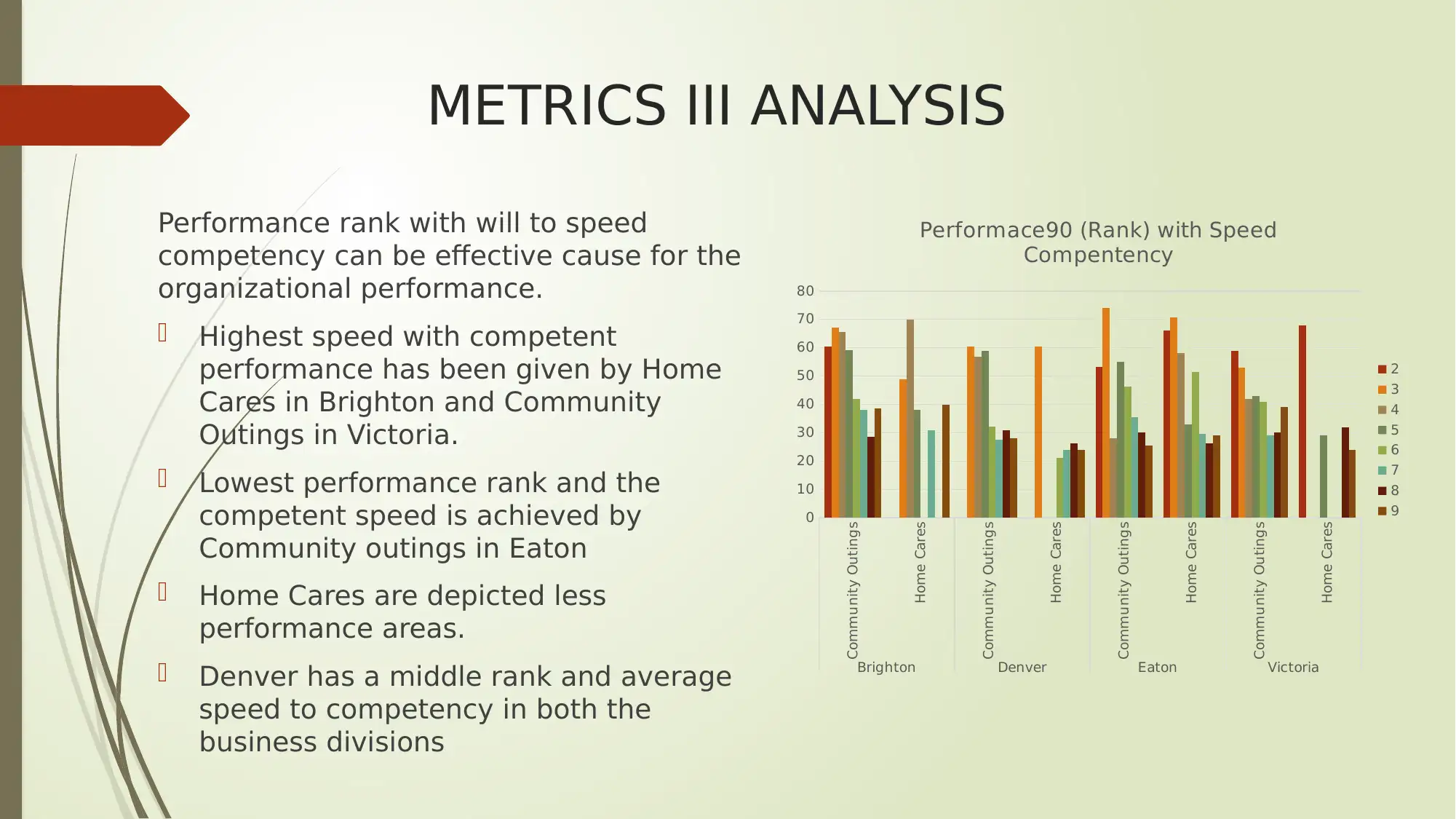
METRICS III ANALYSIS
Performance rank with will to speed
competency can be effective cause for the
organizational performance.
Highest speed with competent
performance has been given by Home
Cares in Brighton and Community
Outings in Victoria.
Lowest performance rank and the
competent speed is achieved by
Community outings in Eaton
Home Cares are depicted less
performance areas.
Denver has a middle rank and average
speed to competency in both the
business divisions
Community Outings
Home Cares
Community Outings
Home Cares
Community Outings
Home Cares
Community Outings
Home Cares
Brighton Denver Eaton Victoria
0
10
20
30
40
50
60
70
80
Performace90 (Rank) with Speed
Compentency
2
3
4
5
6
7
8
9
Performance rank with will to speed
competency can be effective cause for the
organizational performance.
Highest speed with competent
performance has been given by Home
Cares in Brighton and Community
Outings in Victoria.
Lowest performance rank and the
competent speed is achieved by
Community outings in Eaton
Home Cares are depicted less
performance areas.
Denver has a middle rank and average
speed to competency in both the
business divisions
Community Outings
Home Cares
Community Outings
Home Cares
Community Outings
Home Cares
Community Outings
Home Cares
Brighton Denver Eaton Victoria
0
10
20
30
40
50
60
70
80
Performace90 (Rank) with Speed
Compentency
2
3
4
5
6
7
8
9
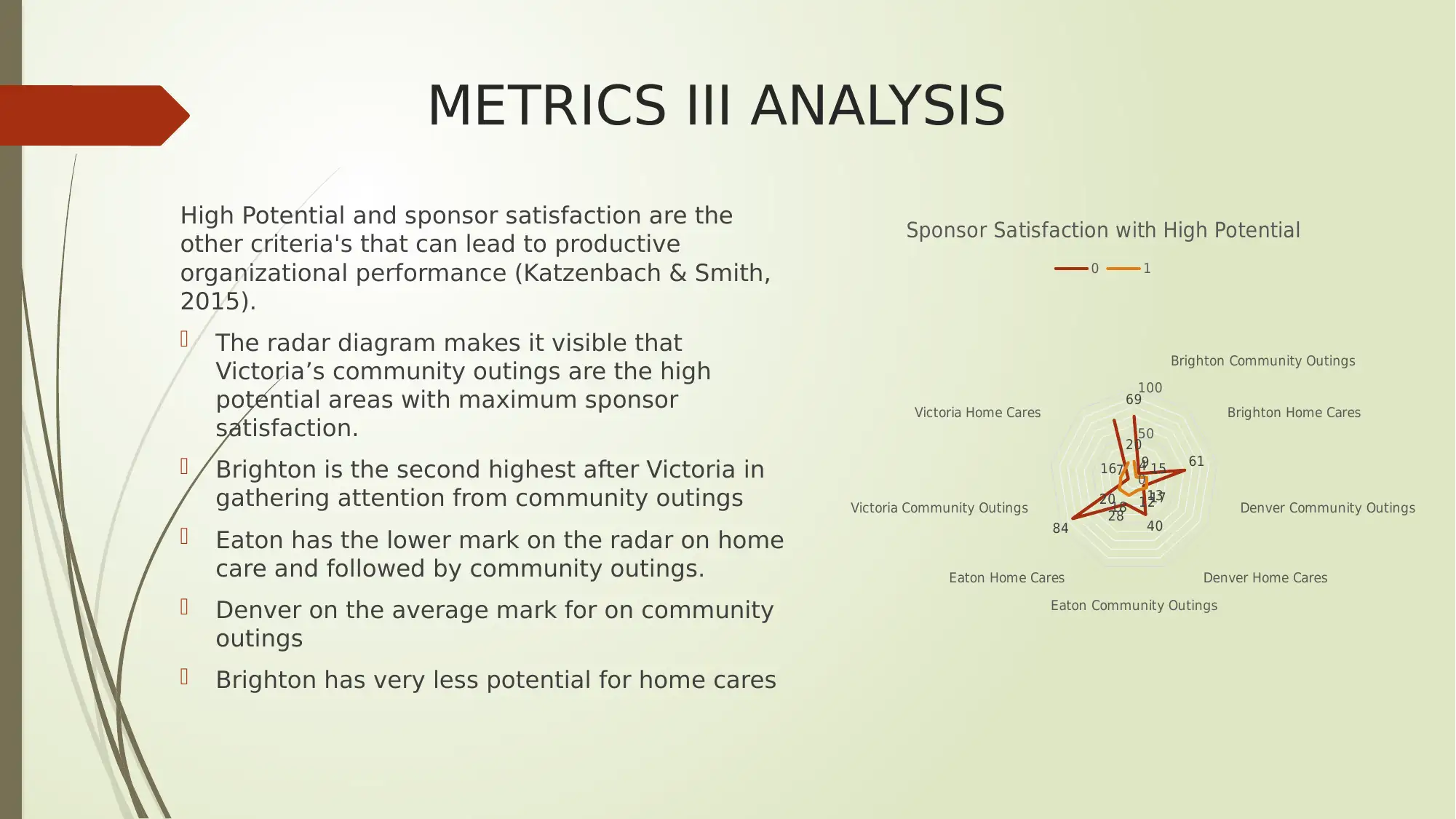
METRICS III ANALYSIS
High Potential and sponsor satisfaction are the
other criteria's that can lead to productive
organizational performance (Katzenbach & Smith,
2015).
The radar diagram makes it visible that
Victoria’s community outings are the high
potential areas with maximum sponsor
satisfaction.
Brighton is the second highest after Victoria in
gathering attention from community outings
Eaton has the lower mark on the radar on home
care and followed by community outings.
Denver on the average mark for on community
outings
Brighton has very less potential for home cares
Brighton Community Outings
Brighton Home Cares
Denver Community Outings
Denver Home Cares
Eaton Community Outings
Eaton Home Cares
Victoria Community Outings
Victoria Home Cares
0
50
100
69
9 61
13
40
28
84
7
20
4 15
171218
20
16
Sponsor Satisfaction with High Potential
0 1
High Potential and sponsor satisfaction are the
other criteria's that can lead to productive
organizational performance (Katzenbach & Smith,
2015).
The radar diagram makes it visible that
Victoria’s community outings are the high
potential areas with maximum sponsor
satisfaction.
Brighton is the second highest after Victoria in
gathering attention from community outings
Eaton has the lower mark on the radar on home
care and followed by community outings.
Denver on the average mark for on community
outings
Brighton has very less potential for home cares
Brighton Community Outings
Brighton Home Cares
Denver Community Outings
Denver Home Cares
Eaton Community Outings
Eaton Home Cares
Victoria Community Outings
Victoria Home Cares
0
50
100
69
9 61
13
40
28
84
7
20
4 15
171218
20
16
Sponsor Satisfaction with High Potential
0 1
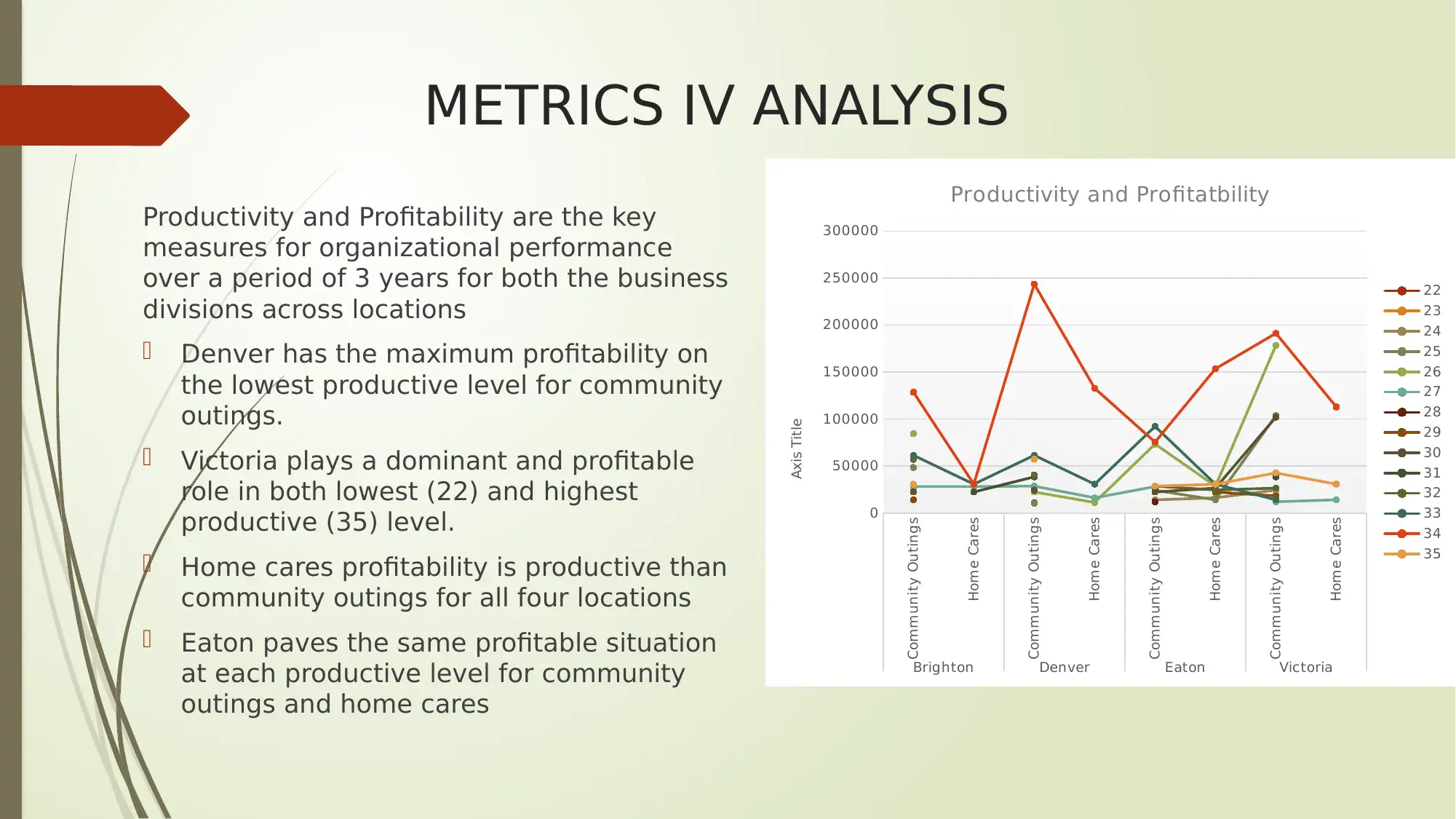
METRICS IV ANALYSIS
Productivity and Profitability are the key
measures for organizational performance
over a period of 3 years for both the business
divisions across locations
Denver has the maximum profitability on
the lowest productive level for community
outings.
Victoria plays a dominant and profitable
role in both lowest (22) and highest
productive (35) level.
Home cares profitability is productive than
community outings for all four locations
Eaton paves the same profitable situation
at each productive level for community
outings and home cares
Community Outings
Home Cares
Community Outings
Home Cares
Community Outings
Home Cares
Community Outings
Home Cares
Brighton Denver Eaton Victoria
0
50000
100000
150000
200000
250000
300000
Productivity and Profitatbility
22
23
24
25
26
27
28
29
30
31
32
33
34
35
Axis Title
Productivity and Profitability are the key
measures for organizational performance
over a period of 3 years for both the business
divisions across locations
Denver has the maximum profitability on
the lowest productive level for community
outings.
Victoria plays a dominant and profitable
role in both lowest (22) and highest
productive (35) level.
Home cares profitability is productive than
community outings for all four locations
Eaton paves the same profitable situation
at each productive level for community
outings and home cares
Community Outings
Home Cares
Community Outings
Home Cares
Community Outings
Home Cares
Community Outings
Home Cares
Brighton Denver Eaton Victoria
0
50000
100000
150000
200000
250000
300000
Productivity and Profitatbility
22
23
24
25
26
27
28
29
30
31
32
33
34
35
Axis Title
Secure Best Marks with AI Grader
Need help grading? Try our AI Grader for instant feedback on your assignments.
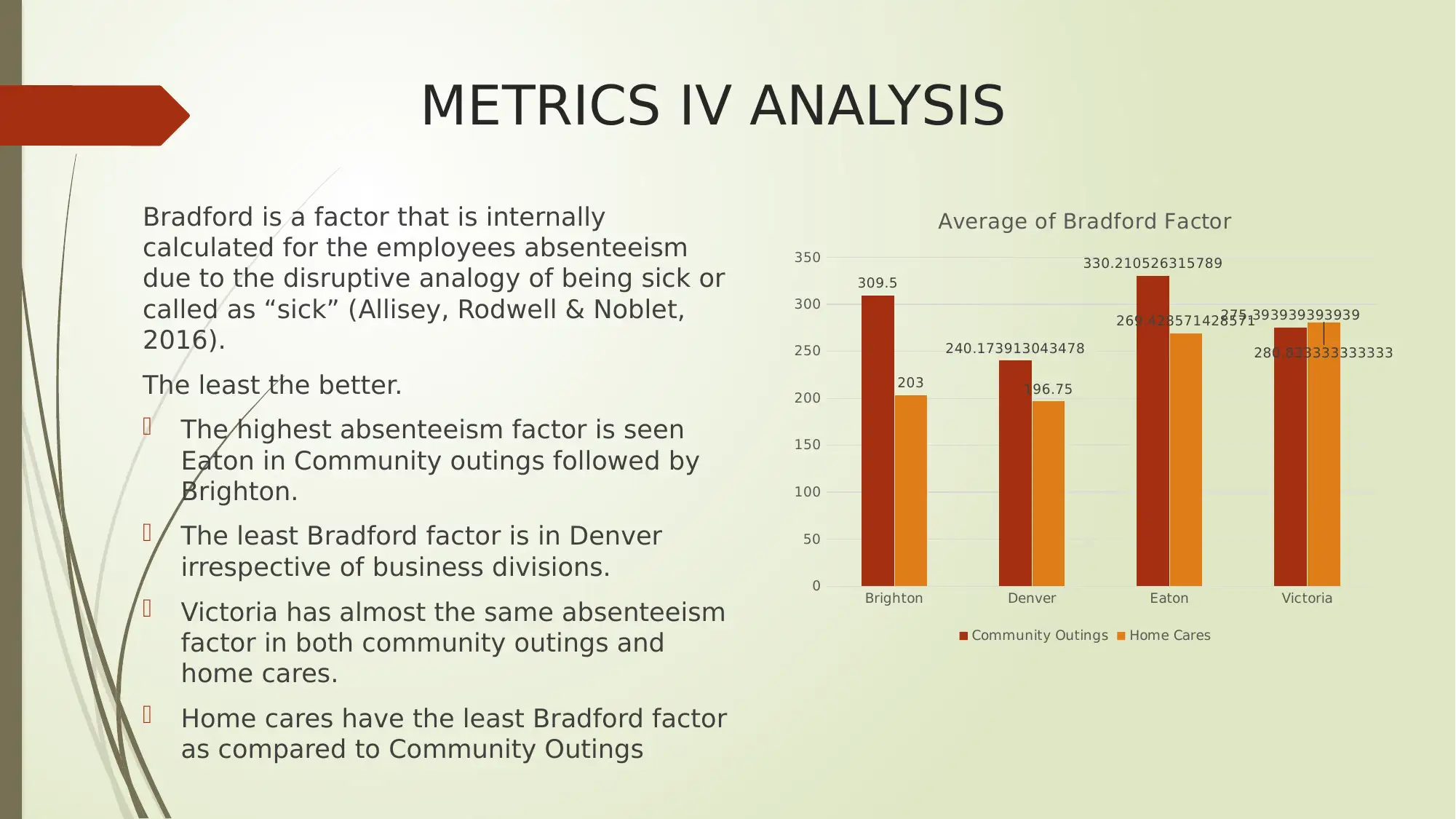
METRICS IV ANALYSIS
Bradford is a factor that is internally
calculated for the employees absenteeism
due to the disruptive analogy of being sick or
called as “sick” (Allisey, Rodwell & Noblet,
2016).
The least the better.
The highest absenteeism factor is seen
Eaton in Community outings followed by
Brighton.
The least Bradford factor is in Denver
irrespective of business divisions.
Victoria has almost the same absenteeism
factor in both community outings and
home cares.
Home cares have the least Bradford factor
as compared to Community Outings
Brighton Denver Eaton Victoria
0
50
100
150
200
250
300
350
309.5
240.173913043478
330.210526315789
275.393939393939
203 196.75
269.428571428571
280.833333333333
Average of Bradford Factor
Community Outings Home Cares
Bradford is a factor that is internally
calculated for the employees absenteeism
due to the disruptive analogy of being sick or
called as “sick” (Allisey, Rodwell & Noblet,
2016).
The least the better.
The highest absenteeism factor is seen
Eaton in Community outings followed by
Brighton.
The least Bradford factor is in Denver
irrespective of business divisions.
Victoria has almost the same absenteeism
factor in both community outings and
home cares.
Home cares have the least Bradford factor
as compared to Community Outings
Brighton Denver Eaton Victoria
0
50
100
150
200
250
300
350
309.5
240.173913043478
330.210526315789
275.393939393939
203 196.75
269.428571428571
280.833333333333
Average of Bradford Factor
Community Outings Home Cares
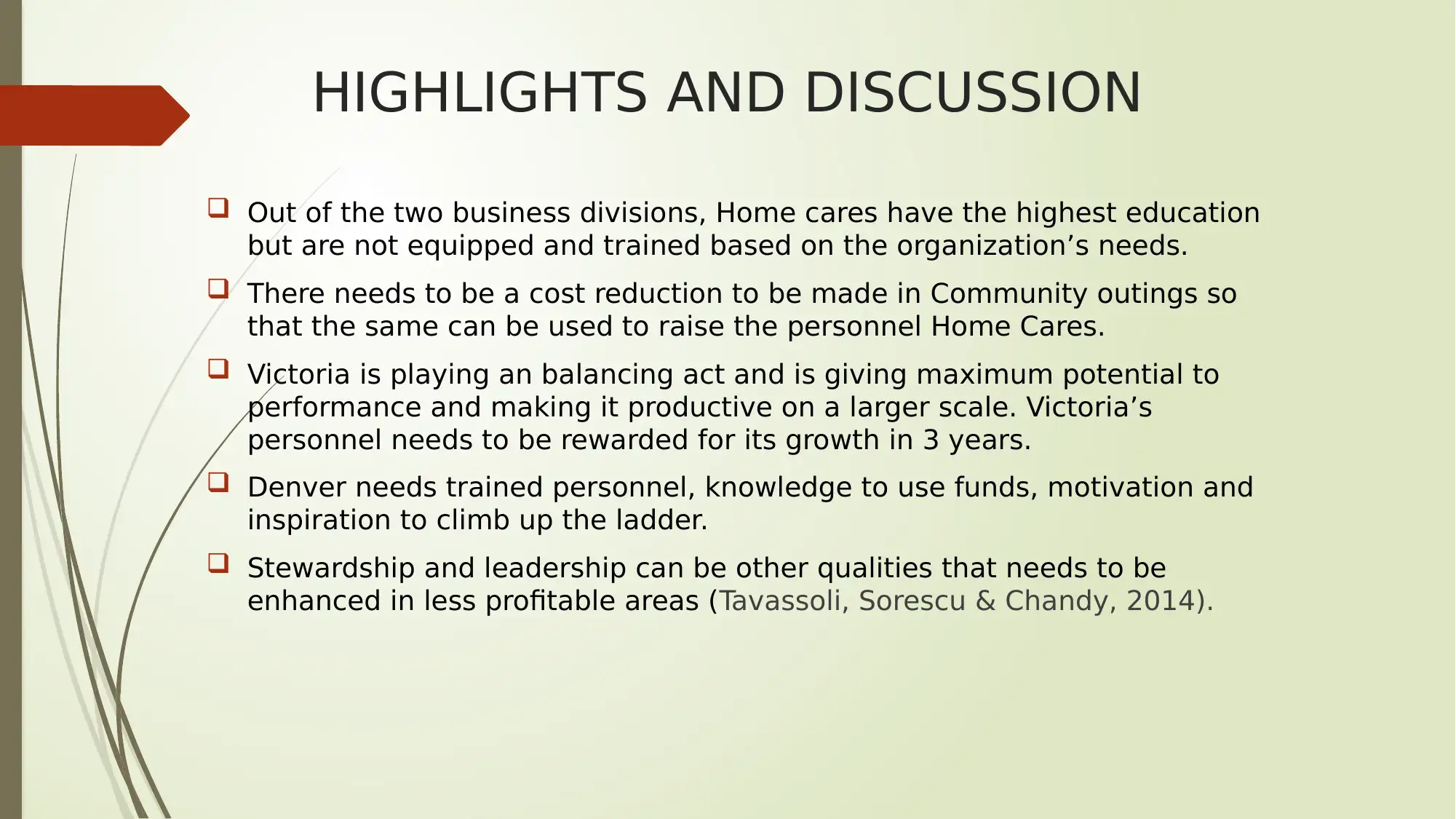
HIGHLIGHTS AND DISCUSSION
Out of the two business divisions, Home cares have the highest education
but are not equipped and trained based on the organization’s needs.
There needs to be a cost reduction to be made in Community outings so
that the same can be used to raise the personnel Home Cares.
Victoria is playing an balancing act and is giving maximum potential to
performance and making it productive on a larger scale. Victoria’s
personnel needs to be rewarded for its growth in 3 years.
Denver needs trained personnel, knowledge to use funds, motivation and
inspiration to climb up the ladder.
Stewardship and leadership can be other qualities that needs to be
enhanced in less profitable areas (Tavassoli, Sorescu & Chandy, 2014).
Out of the two business divisions, Home cares have the highest education
but are not equipped and trained based on the organization’s needs.
There needs to be a cost reduction to be made in Community outings so
that the same can be used to raise the personnel Home Cares.
Victoria is playing an balancing act and is giving maximum potential to
performance and making it productive on a larger scale. Victoria’s
personnel needs to be rewarded for its growth in 3 years.
Denver needs trained personnel, knowledge to use funds, motivation and
inspiration to climb up the ladder.
Stewardship and leadership can be other qualities that needs to be
enhanced in less profitable areas (Tavassoli, Sorescu & Chandy, 2014).
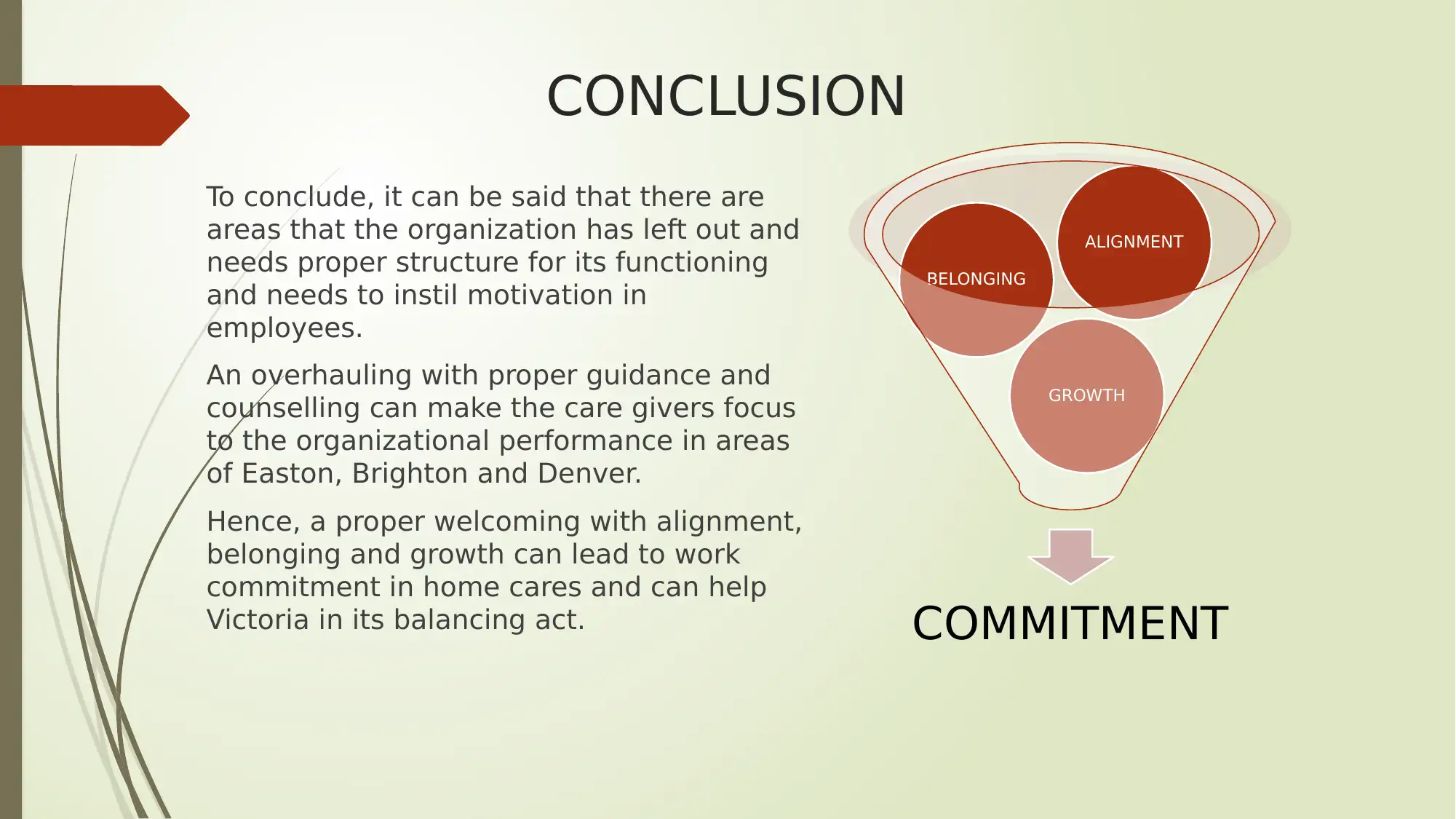
CONCLUSION
To conclude, it can be said that there are
areas that the organization has left out and
needs proper structure for its functioning
and needs to instil motivation in
employees.
An overhauling with proper guidance and
counselling can make the care givers focus
to the organizational performance in areas
of Easton, Brighton and Denver.
Hence, a proper welcoming with alignment,
belonging and growth can lead to work
commitment in home cares and can help
Victoria in its balancing act. COMMITMENT
GROWTH
BELONGING
ALIGNMENT
To conclude, it can be said that there are
areas that the organization has left out and
needs proper structure for its functioning
and needs to instil motivation in
employees.
An overhauling with proper guidance and
counselling can make the care givers focus
to the organizational performance in areas
of Easton, Brighton and Denver.
Hence, a proper welcoming with alignment,
belonging and growth can lead to work
commitment in home cares and can help
Victoria in its balancing act. COMMITMENT
GROWTH
BELONGING
ALIGNMENT
Paraphrase This Document
Need a fresh take? Get an instant paraphrase of this document with our AI Paraphraser
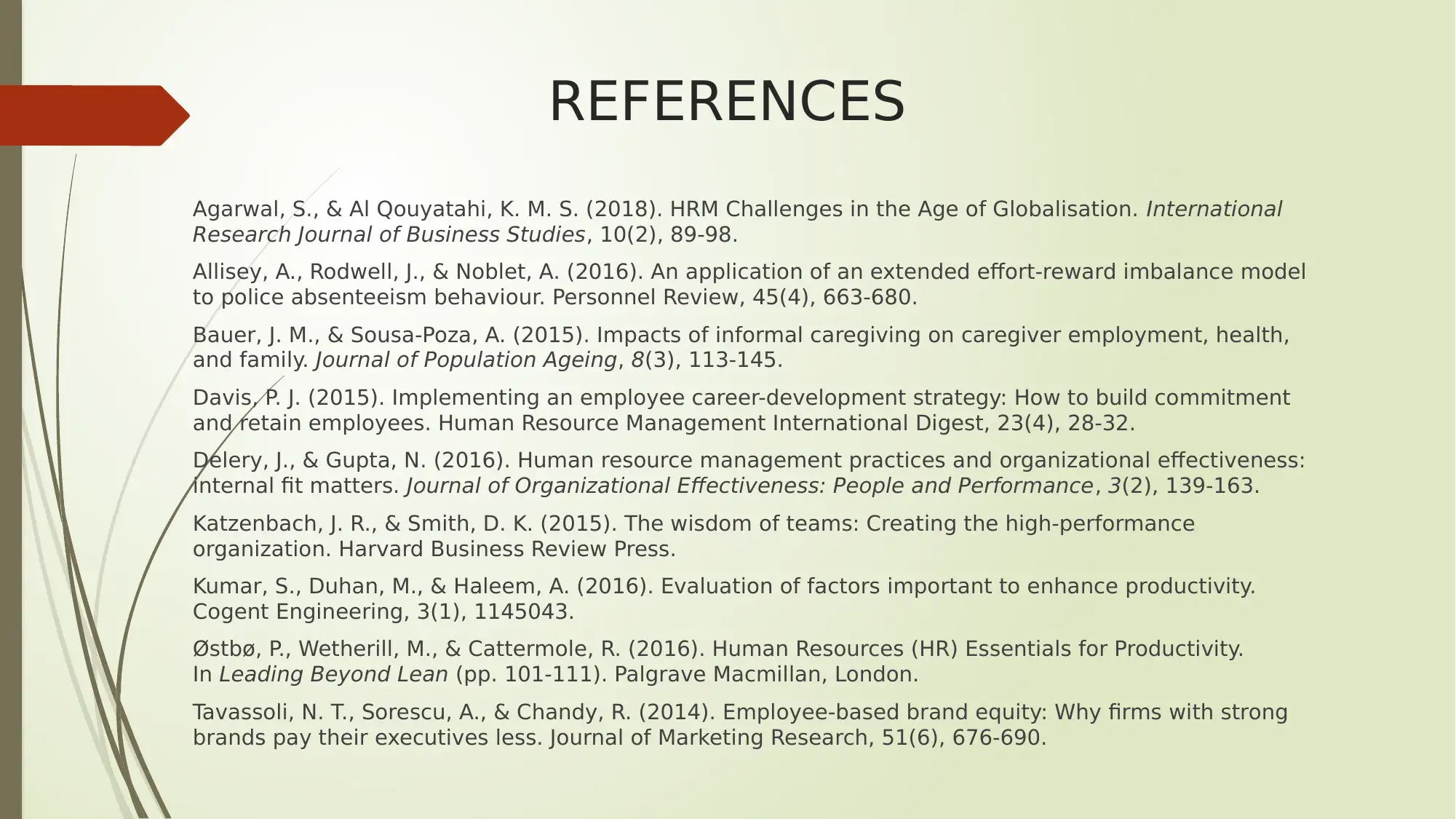
REFERENCES
Agarwal, S., & Al Qouyatahi, K. M. S. (2018). HRM Challenges in the Age of Globalisation. International
Research Journal of Business Studies, 10(2), 89-98.
Allisey, A., Rodwell, J., & Noblet, A. (2016). An application of an extended effort-reward imbalance model
to police absenteeism behaviour. Personnel Review, 45(4), 663-680.
Bauer, J. M., & Sousa-Poza, A. (2015). Impacts of informal caregiving on caregiver employment, health,
and family. Journal of Population Ageing, 8(3), 113-145.
Davis, P. J. (2015). Implementing an employee career-development strategy: How to build commitment
and retain employees. Human Resource Management International Digest, 23(4), 28-32.
Delery, J., & Gupta, N. (2016). Human resource management practices and organizational effectiveness:
internal fit matters. Journal of Organizational Effectiveness: People and Performance, 3(2), 139-163.
Katzenbach, J. R., & Smith, D. K. (2015). The wisdom of teams: Creating the high-performance
organization. Harvard Business Review Press.
Kumar, S., Duhan, M., & Haleem, A. (2016). Evaluation of factors important to enhance productivity.
Cogent Engineering, 3(1), 1145043.
Østbø, P., Wetherill, M., & Cattermole, R. (2016). Human Resources (HR) Essentials for Productivity.
In Leading Beyond Lean (pp. 101-111). Palgrave Macmillan, London.
Tavassoli, N. T., Sorescu, A., & Chandy, R. (2014). Employee-based brand equity: Why firms with strong
brands pay their executives less. Journal of Marketing Research, 51(6), 676-690.
Agarwal, S., & Al Qouyatahi, K. M. S. (2018). HRM Challenges in the Age of Globalisation. International
Research Journal of Business Studies, 10(2), 89-98.
Allisey, A., Rodwell, J., & Noblet, A. (2016). An application of an extended effort-reward imbalance model
to police absenteeism behaviour. Personnel Review, 45(4), 663-680.
Bauer, J. M., & Sousa-Poza, A. (2015). Impacts of informal caregiving on caregiver employment, health,
and family. Journal of Population Ageing, 8(3), 113-145.
Davis, P. J. (2015). Implementing an employee career-development strategy: How to build commitment
and retain employees. Human Resource Management International Digest, 23(4), 28-32.
Delery, J., & Gupta, N. (2016). Human resource management practices and organizational effectiveness:
internal fit matters. Journal of Organizational Effectiveness: People and Performance, 3(2), 139-163.
Katzenbach, J. R., & Smith, D. K. (2015). The wisdom of teams: Creating the high-performance
organization. Harvard Business Review Press.
Kumar, S., Duhan, M., & Haleem, A. (2016). Evaluation of factors important to enhance productivity.
Cogent Engineering, 3(1), 1145043.
Østbø, P., Wetherill, M., & Cattermole, R. (2016). Human Resources (HR) Essentials for Productivity.
In Leading Beyond Lean (pp. 101-111). Palgrave Macmillan, London.
Tavassoli, N. T., Sorescu, A., & Chandy, R. (2014). Employee-based brand equity: Why firms with strong
brands pay their executives less. Journal of Marketing Research, 51(6), 676-690.
1 out of 14
Your All-in-One AI-Powered Toolkit for Academic Success.
+13062052269
info@desklib.com
Available 24*7 on WhatsApp / Email
![[object Object]](/_next/static/media/star-bottom.7253800d.svg)
Unlock your academic potential
© 2024 | Zucol Services PVT LTD | All rights reserved.
